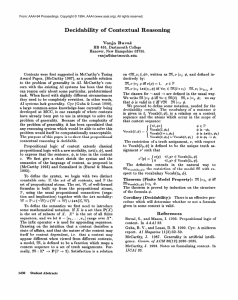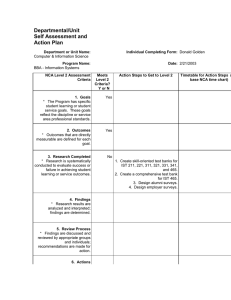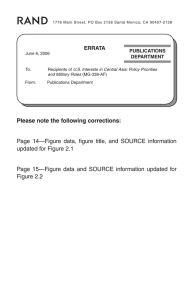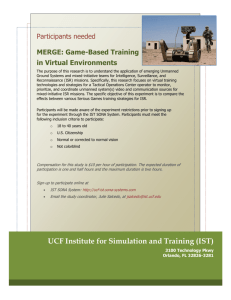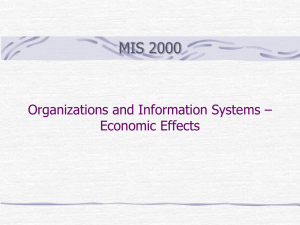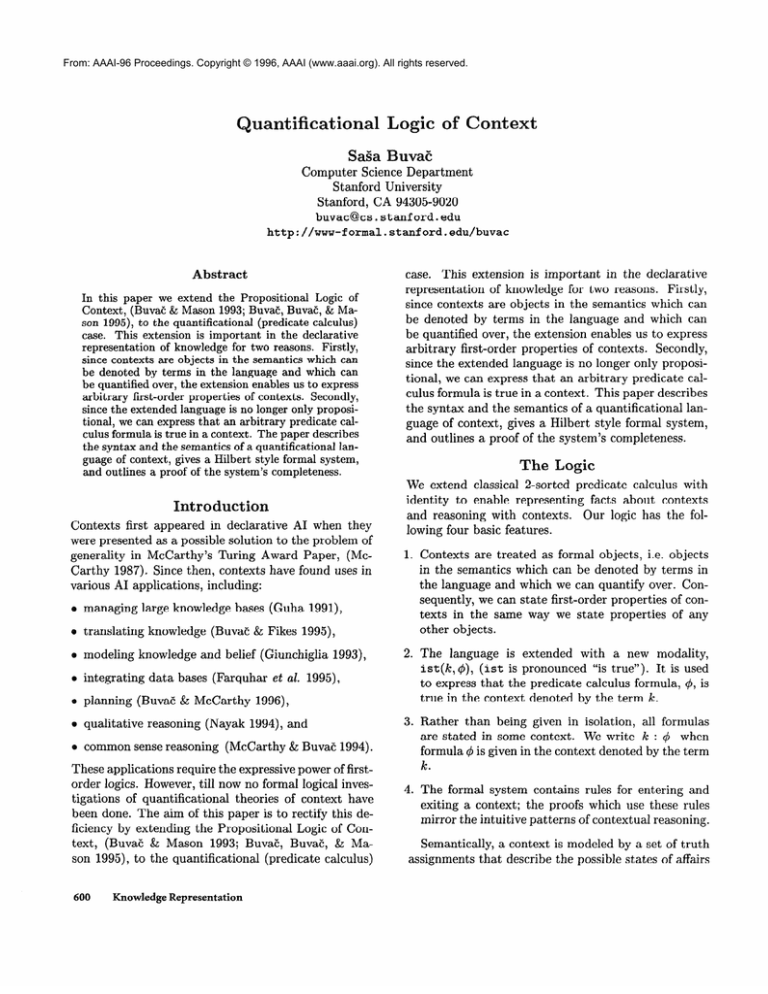
From: AAAI-96 Proceedings. Copyright © 1996, AAAI (www.aaai.org). All rights reserved.
Quantifkational
Logic of Context
SaSa BuvaC
Computer Science Department
Stanford University
Stanford, CA 94305-9020
buvac@cs.stanford.edu
http://www-formal.stanford.edu/buvac
Abstract
In this paper we extend the Propositional Logic of
Context, (Buvac & Mason 1993; BuvaE, BuvaE, & Mason 1995), to the quantificational (predicate calculus)
case. This extension is important in the declarative
representation of knowledge for two reasons. Firstly,
since contexts are objects in the semantics which can
be denoted by terms in the language and which can
be quantified over, the extension enables us to express
arbitrary first-order properties of contexts. Secondly,
since the extended language is no longer only propositional, we can express that an arbitrary predicate calculus formula is true in a context. The paper describes
the syntax and the semantics of a quantificational language of context, gives a Hilbert style formal system,
and outlines a proof of the system’s completeness.
Introduction
Contexts
first appeared
in declarative
AI when they
were presented as a possible solution to the problem of
generality in McCarthy’s Turing Award Paper, (McCarthy 1987). Since then, contexts have found uses in
various AI applications,
including:
managing large knowledge bases (Guha 1991))
translating knowledge (BuvaE & Fikes 1995),
modeling knowledge and belief (Giunchiglia 1993))
integrating data bases (Farquhar et al. 1995),
planning (BuvaE & McCarthy 1996),
qualitative reasoning (Nayak 1994), and
common sense reasoning (McCarthy & BuvaE 1994).
These applications require the expressive power of firstorder logics. However, till now no formal logical investigations of quantificational theories of context have
been done. The aim of this paper is to rectify this deficiency by extending the Propositional Logic of Context, (Buvac & Mason 1993; BuvaE, BuvaE, & Mason 1995), to the quantificational (predicate calculus)
600
Knowledge Representation
case. This extension is important in the declarative
representation of knowledge for two reasons. Firstly,
since contexts are objects in the semantics which can
be denoted by terms in the language and which can
be quantified over, the extension enables us to express
arbitrary first-order properties of contexts. Secondly,
since the extended
language
is no longer only proposi-
tional, we can express that an arbitrary predicate calculus formula is true in a context. This paper describes
the syntax and the semantics of a quantificational language of context, gives a Hilbert style formal system,
and outlines a proof of the system’s completeness.
The Logic
We extend classical 2-sorted predicate calculus with
identity to enable representing facts about contexts
and reasoning with contexts. Our logic has the following four basic features.
Contexts are treated as formal objects, i.e. objects
in the semantics which can be denoted by terms in
the language and which we can quantify over. Consequently, we can state first-order properties of contexts in the same way we state properties of any
other objects.
The language is extended with a new modality,
ist(J&4), (ist is pronounced “is true”). It is used
to express that the predicate calculus formula, 4, is
true in the context denoted by the term Ic.
Rather than being given in isolation, all formulas
are stated in some context. We write Ic : 4 when
formula 4 is given in the context denoted by the term
lc.
The formal system contains rules for entering and
exiting a context; the proofs which use these rules
mirror the intuitive patterns of contextual reasoning.
Semantically, a context is modeled by a set of truth
assignments that describe the possible states of affairs
of that context. Thus a model will associate a set of
first-order structures with every context. These firstorder structures reflect the states of affairs which are
possible in that context. For an atom to be true in a
context, it has to be satisfied by all the structures associated with that context. Therefore, the ist modality is interpreted as validity: ist(k,p)
is true iff the
atom p is true in all the first-order structures associated with context Ic. Treatment of ist as validity also
corresponds to Guha’s proposal for context semantics,
which was motivated by the Cyc knowledge base.
The formal system captures some intuitive patterns
of contextual reasoning. Intuitively, to prove that a formula is true in some context, we want to first enter that
context, perform some inferences with the assumptions
made in that context to derive our goal formula, and finally exit the context. When sub-formulas of a formula
we want to prove pertain to different contexts, we derive the sub-formulas in their corresponding contexts,
and then put them together in the original context to
obtain the desired formula. To capture this style of
reasoning, we define derivability as a relation on a formula 4 given in a context k, and write l-k : 4. We
also introduce the inference rules (Enter) and (Exit)
which enable the reasoning system to enter and exit
a context. In (McCarthy 1993), McCarthy illustrates
how such rules can be used to generate the desired
pattern of reasoning.
We proceed to present some technical details of the
logic and a brief sketch the aspects of the completeness
proof which are new to the quantificational case. We
use standard mathematical notation; we use P(X) to
refer to the set of subsets of X. To simplify the formulas we will distinguish between context objects and
non-context objects by assuming two disjoint sorts: the
context sort and the non-context sort. The latter is referred to as the discourse sort, reflecting the intuition
that the non-context objects will be the topic of discourse.
Syntax
A language L of our logic is any language of classical 2-sorted predicate calculus with identity. Formally,
language L is a collection of the constants and the predicates of all arities. We call the sorts the context sort
and the discourse sort.
We now fix some language LG.The set of all terms in
our logic, T, is identical to the set of terms of classical
2-sorted predicate calculus with identity over the same
language L. Formally, ‘ll? is the set of variables and
constants (of both sorts) of the language L. We use lK
to refer to the set of terms of the context sort, and V to
refer to the set of variables of both sorts. Note that for
simplicity of presentation, our logic has no functions.
The set of atomic formulas, VQ, is the set of atomic
formulas of classical 2-sorted predicate calculus with
identity: non-logical predicates and the identity predicate applied to an appropriate number of arguments of
appropriate sorts. The set VV, of well-formed formulas
(wffs) of our logic, is defined as the least set satisfying
W := Wo U (1W) U (W -+ W) U (VV)W
U
ist(I&W)
The operations A, V, t), and quantifier 3 are assumed
to be defined as abbreviations in the usual way. We will
use Wpc to refer to the set of well-formed formulas of
classical predicate calculus with identity, i.e. formulas
which do not contain the ist modality. To simplify
presentation, we assume that the set of bound variables
is disjoint from the set of free variables.
We adopt the following notational conventions:
range over constants; v, VI, . . . range over varia,al,...
ables; t, tl, . . . range over terms; Ic,ICI,. . . range over
terms of only the context sort; and p, pl, . . . range over
predicates. Lower case Greek letters range over W.
The letter T ranges over (possibly infinite, possibly
empty) sets of wffs. Note that since all the formulas
we will be concerned with are well-formed, the sorts of
terms will often be obvious, and will thus not need to
be stated explicitly. Similarly, we often do not explicitly list all the arguments of predicates.
Semantics
We begin by fixing some language l, and defining
STR(IS) to be the collection of classical 2-sorted firstorder structures CCC’,D>,Z>, i.e. C and D are non
empty sets, and Z is standard two-sorted interpretation function for the language ,!Z. Intuitively, the set C
should be interpreted as the set of context objects, and
the set D should be interpreted as the set of discourse
objects of the particular structure.
By convention, gothic letters will range over elements of STR(L).
If 24 = <CC’,D>,Z>, then we use
Z(U) to refer to Z, the interpretation function of the
first-order structure Q; we use I%[” to refer to C, the
set of context objects in the domain of the first-order
structure rU; we use l%ld to refer to D, the set of discourse objects in the domain of the first-order structure
rU;and we use I%[ to refer to CUD, the set of all objects
in the domain of the first-order structure !&.
Definition (9Jl):
A model, tm, is a function which
maps each context object to a (possibly empty) set of
2-sorted first-order structures of the language ,C,
%V: Dom(mZ) -+ P(STR(L)),
provided the following conditions hold:
Knowledge Bases h Context
601
1 The domains of all first-order structures of all contexts are the same. Formally, for any two context
objects cl and ~2, for any first-order structures !Z E
!?X(ci) and 93 E 9X(c2), ]rU(”= 1931’and I%]d = pqd.
We use ]5Z(c to refer to the set of context objects
I%]‘, we use ]!JXldto refer to the set of discourse objects IaId, and we use ]rnZ]to refer to the set of all
objects ]U). By convention, c,cl,. . . range over 19X]‘;
d,dl,. . . range over ]!?JZld;and e,ei,. . . range over 19X].
The set of context objects, [9X]“, is disjoint from the
set of discourse objects, ]%R(d.
The domain of the model, Dom(!JX), is identified
with the set of context objects, ]9.X]“.
We require that all interpretation functions map a
constant to the same object; we say that all constants are rigid designators.
Formally, for any U E
rSn(cr) and 93 E 9X(c2), and for any constant a, we
have X(%)(a) = Z(%)(a).
A variable asDefinition (variable assignment):
signment is a function from the set of variables, V, to
the set of all objects, ]Z?X],providing variables are assigned objects of appropriate sorts. We extend the
variable assignment to constants; this is trivial since
all the constants are rigid designators.
By convention, the Greek letters CJand 7 will range
over variable assignments. Instead of writing O(V), we
will use the common notation and write v[o].
We introduce b=, which is a relation on a model, a
first-order structure, a context, a formula and a variable assignment. The relation I=, which is written
9X, U + k : 4 [a], should be interpreted as a satisfuction relation: we say that the model 9X, the first-order
structure U, and the variable assignment o satisfy the
formula 4 in context k[a].
Fexfip;ltio? (b) :
If rz1E 9X(k[a]) then !3X,a k
.
is defined by induction on the structure on
x,’as ;iollows:
m,su
+
. . , ti) [a] if
Ii :p(h,.
j= k : 4
iff
(V9JZ)(V% E 9X(k)) (Vu)
We write
9X, 5%b k : C#J
[a]. We call this relation validity.
Note that in the clause for universal quantification,
the term k can not be the variable v since we have
assumed that the set of bound variables is disjoint from
the set of free variables.
Formal
t--k:4
iffk:#isan
Definition (derivability) :
instance of an axiom schema or follows from provable
formulas by one of the inference rules. Formally, I- k :
4 iff there is a sequence [kl : &, . . . , km : $“] such
that km = k and 4” = 4 and for each i 5 m either
ki : C@ (1) is an instance of one of the axiom schemas,
or (2) follows from earlier elements in the sequence via
one of the inference rules.
The axiom schemas and inference rules naturally divide
into three groups.
1.
?lX,!i?i~k:+[a]
t2
[u]
if
not
if
9X, U b k : 4 + QJ[a]
k :4
WI)
k : W+#J(V) + $0)
(t =)
k :t = t
(p =)
k : (ti = t!,) +
k:$
UJG)
2.
if
implies
for all e E (U( of the same
if
for all 93 E ?JX(k’[a])
m, 23 /= k’: q5[a]
602
Knowledge
Representation
ti4,t:,ti+1,...,
k : 4 + Tw
. . , tn)
tn))
provided u is not free in 4.
k : q5 -+ (Vv’)$(v’)
(K)
k : ist(k’,
(A)
k : ist(kl,
(Flat)
%R%~k:q5[la]
sort as 21 9X, Iu + k : q5[a(~ := e)]
9X, U + k : ist(k’, $) [a]
(p(tl, . . . , tieI, ti, ti+l,.
k:&--+~
k . $,
.
Propositional
Properties of Contexts.
4 --+ $) -+ (ist(k’,
ist(ka,+))
k : ist(k1, ist(kz,$))
(Enter)
~,w==:2cIbl
m, % b k : (‘t/v)4 [a]
provided 4 is a propositional tautology.
4) + ist(k’, $))
V ist(ki,list(kz,
4))
= 37%>(t2[4)
9X, ‘u + k : f$[a]
if
(PL)
cMP)
< X(rU)(t,[a]), . . . ,
z(U>(tl[a]>
Classical Predicate Calculus.
-+p(t1,...,
ww (t&3> ’ E ww cd
Em,!-ab k : t1 =
System
Since all formulas in our logic are given in some context
(rather than being given in isolation) derivability is a
relation on a formula and a context. We write I- k : 4
and say that formula q5 is derivable in context k. We
define derivability in a Hilbert style.
3.
k’ : ist(k,
k . 4
.
4)
Quantificational
(BF)
(ist
k : (Vv)ist(k’,4)
=)
t) ist(k2, $)
(Exit)
k ’’
k’ : ist(k,
4)
Properties of Contexts.
+ ist(k’,
k : (tl = t2) f) ist(k’,
(VV)~)
tl = t2)
We briefly comment on the axioms and inference rules.
The first set of axioms and rules guarantees that all
valid formulas of classical predicate calculus with identity hold in every context, and every context is closed
with respect to the classical rules of inference. The
second set of axioms and rules captures the propositional modal properties of contextual reasoning. The
axiom schema (K) guarantees that every context is
closed with respect to logical consequence. A property we call contextual omniscience is captured by the
(A) axiom. Intuitively, every context “knows” what
is true in every other context. Thus, although a context need not have complete information about what
is true in the world, it will have complete information
about other contexts’ views of the world. If we interpret contexts as knowledge bases, then contextual omniscience states that every knowledge base “can see”
into any other knowledge base. The axiom schema
(Flat) tells us that every context looks the same regardless of which context it is being viewed from. Rules
(Enter) and (Exit) allow the formal system to respectively enter and exit a context. Note that the (Enter)
rule is the converse of the (Exit) rule. The third set of
axioms and rules captures the quantificational properties of contexts. The Barcan formula (BE’) is needed
to make the domains of all the first-order structures in
all of the contexts be the same. The (ist =) tells us
that all terms are treated as rigid designators.
Completeness
In this section we state the completeness of the system and outline the proof. The general structure of
the completeness proof and a number of lemmas are
similar to those of the propositional system presented
in (Buvac, BuvaE, & Mason 1995). We will demonstrate the aspects of the proof which are novel to the
quantificational case.
Theorem
(completeness) :
l-k:@
iff
kk:+.
The (+) direction is the soundness lemma. It is simple to verify that the axioms are sound and that the
rules preserve soundness. We proceed by introducing
some concepts which will be needed to outline the (+)
direction of the completeness proof.
Definition (satisfiability):
A set of formulas T is
satisfiable in Ic iff there exists a model 9X, first-order
structure 24, and a variable assignment B such that for
all 4 E T ‘3X,% + Ic :$[a].
Definition (consistency):
A formula 4 is consistent in Ic iff not I- !C: 14. A finite set of formulas T
is consistent in Ic iff /X\T, the conjunction of all the
formulas in T, is consistent in k. An infinite set T is
consistent in Ic iff every finite subset of T is consistent
in k. A set T is inconsistent in ir, iff the set T is not
consistent in Ic. A set T is maximally consistent in k
iff T is consistent in k and for all 4 if 4 $ T, then
T U {4} is inconsistent in k.
Definition (w-completeness):
A set of sentences
T is w-complete
iff for any formula 4 we have
(V’V)~(ZJ)4 T implies -q!(t) E T for some term t.
Given a set of formulas T in /CO,we will define the
set Tk to be those formulas from T which “talk only
about” the particular context Ic, (in the sense that they
are true in that context and they contain no ist modalities). The set of formulas TI,, will be used to define
the part of the model of T which describes the state of
affairs in the context k.
Definition (Tk):
If T is a set of formulas given in
ke, then TI, := (41 ist(fc,+) E T and 4 E V&c}.
We say that TI, is defined from T in ke.
As is usual, an important part of the completeness
proof is the Lindenbaum lemma, allowing any consistent set of wffs to be extended to a maximally consistent set. Our completeness proof will be based on
a Henkin construction, which means that in parallel
to the process which makes the set maximally consistent, we will also provide witnesses for all previously
un-witnessed existential formulas. In a Henkin construction, it is standard to expand the language of the
original theory with some infinite set of new constants
and use these as witnesses. Our method is similar:
previously unused variables will be witnesses. The advantages of using variables for witnesses is that we do
not need to change the language of the original set of
sentences. We simply need an infinite supply of unused
variables.
Notational convention (unused variables) :
Assume a set of formulas T is given in some context Ice.
We use p to denote an infinite set of new context variables, and 9’ an infinite set of new discourse variables.
We use 6,&,...
to range over @ U P.
Lemma (Lindenbaum) :
Assume the set of formulas Te is given in Lo, and that the variables in @ and
vid are not used in Te or in ke. If To is consistent in
Ice, then Te can be extended to a maximally consistent
set T in Ice, such that every non-empty set TI, (defined
from T in Ice) is w-complete.
We proceed to outline the proof that any set of formulas To which is consistent in /COmust be satisfiable
in Ice. It is simple to show that this is equivalent to the
(-+) of the completeness theorem.
Knowledge Bases & Context
603
Proof (completeness) :
Assume To is consistent
in ko. We extend the set of variables V used in To and
k0 with an infinite set of new context variables ‘@ and
an infinite set of new discourse variables vd which do
not occur in To or in ko.
By the (Lindenbaum lemma) we can extend To
to a maximally consistent set T in ko. Using T we will
construct the model !JXfrom terms of the language L.
We identify the sets of objects with the sets of terms:
I9JZl”is defined to be the set of all context terms and
bWdis defined to be the set of all discourse terms.
From the maximally consistent set T, for every c, we
read off the set T,. Note that since we identified objects in the model with terms, we are able to interchangeably use terms and objects. Thus we will talk
about T, rather than Tk.
Now we define the set of first order structures associated with a context c. The set of sentences T, can be
thought of as describing the state of affairs which hold
at c. We will define the model 9X so that associates
the context c with the first-order structures which correspond to this state of affairs. In order to read off
these first-order structures we first use T, to construct
?c, the set of all maximally consistent extensions of
T,. For every set T, we define ?‘, := {T I T is a maximally consistent extension of T,}. Every T’ E ?!‘c will
be w-complete since T’ C T. Now every T’ E ?, is
used to read off a first-order structure U; since T’ is
maximally consistent and w-complete this can be done
in the usual way. All the first-order structures ‘5%obtained in this way are put together to define %8(c), the
set which the model 9X will associate to the context c.
This completes the construction of ?JJ?.. By (9X
lemma) we are guaranteed that the model we have
constructed is indeed a model.
Lemma (9X):
The ?JX constructed in the (completeness proof) is a model, i.e. it satisfies the additional conditions imposed by the definition of a model.
Finally, to establish completeness we need only show
that the model 9X is in fact a model of the sentences
To we had started off with. This will be guaranteed
by the truth lemma. We define aid to be the identity
function.
Lemma (truth):
ist(c, 4) E T
iff
V% E %X(c)
332,u i= c : 4 [tTid].
Clearly, if 4 E To, then also 4 E T. Since T was
given in context ko, by (Exit) rule it follows that
ist(ko,+)
E T, and therefore by the (truth lemma)
we get 9X, % k ko : 4 [a]. This completes the outline of
the completeness proof. Qompleteness
604
Knowledge Representation
The proof of the truth lemma is similar to its propositional counterpart. The only new case, that for universal quantifiers, follows simply since having both directions of the Barcan formula enables us to “pull out”
all the quantifiers from within an ist.
To construct a model the standard Henkin construction needs a number of interesting modifications. We
illustrate these by outlining the proof of the Lindenbaum lemma. But first we need to state some simple
properties of consistency.
Lemma (consistency) :
then for any wff 4
If T is consistent in ko,
1. at least one of: T U { +}, T U { 74)
is consistent in
ko;
2. if T U {list(k,
(Vu)+(v))}
is consistent in ko, then
T U Wk
+h>>l is also consistent in ko, provided
~1 does not occur free in T, k, or $.
Proof (Lindenbaum) :
Our proof of the Lindenbaum lemma is based on a Henkin construction.
We enumerate all the sentences in the language C:
and construct an increasing sequence of conbo,h,sistent sets To c T1 C T2 c . . . of sentences of L such
that:
1. Each Ti is consistent.
(VV)$(V)) and +i
E Ti+l, then
where
fiP
is
the
first variable
ist(k, 4&J) E %+I,
from @ or qd (depending on its sort) not occurring
in Ti, &, or k.
3. If $i
=
ist(k,
Now we will construct this sequence of sets of sentences, and prove that it has the above properties l-3.
The construction proceeds in two stages. Assuming
we already have the set Ti, we will first construct a
temporary set Ti which will take care of condition 2.
Then, in the second stage, using this temporary set Ti
we construct Ti+l by adding witness axioms thus also
satisfying condition 3.
We elaborate the first stage. Let
T’i =
Ti u (4i)
Ti U {l+i}
if Ti U (g&j is consistent in ko
if Ti U { $}
is consistent in ko
Note that from the fact that T is consistent in ko and
the (consistency lemma 1) it follows that one of the
two choices above has to be consistent. Therefore, this
takes care of condition 2. above. Note that often it will
be the case that more than one of the above choices
is consistent. In this case we can arbitrarily choose
which sentence will be added to Ti. However different
choices will lead to the construction of different maximally consistent sets which gives us some control over
the models we create.
Now we elaborate the second stage of the construction. Let Ti+i be Ti U {ist(k, $(GP))} if & =
ist(k, (VV)+(ZJ))&+
E Ti, and Tf otherwise, where
$ is the first variable from @ or vd (depending on its
sort) not occurring in Ti, &, or k. This clearly takes
care of the conditions 3. above. All that remains to be
shown is that condition 1. holds, i.e. that the set Ti+r
is consistent. Clearly the set T: produced after the
first stage of the construction is consistent. By (consistency
lemma
2) the second stage also produces a
consistent set. Therefore, condition 1. holds. Thus
we have shown that the sequence of theories which we
have constructed has properties l-3 given above.
We define the set T := Ug,Ti.
It is straight forward
to show that it is maximally consistent. &,indenbaum
A Simple Example
We proceed to illustrate that the quantificational features introduced in this paper are necessary in order
to represent real world knowledge in the framework of
context logics.
Assume the page for 06/23/96 in McCarthy’s diary
contains the formula
fZy( UA, 921, San-Francisco,
7:00, LA, 821)
which is intended to mean that on 06/23/96 McCarthy
is scheduled to fly to Los Angeles on flight 921, leaving San Francisco at 7:00 and arriving in LA at 821.
Note that although the term McCarthy is not mentioned in the above formula, the entry implicitly pertains to McCarthy since the formula is given in McCarthy’s diary. Similarly, although the term 06/23/96
is not mentioned, the entry implicitly pertains to the
date 06/23/96 since the formula is entered in the diary
page associated with that particular date.
One of the original motivations for context formalisms was to aid in expressing such implicit assumptions without having to modify the formula itself
(as is proposed in (McCarthy 1993)). Unfortunately,
the propositional language of context is not expressive
enough to handle even this simple example.
The quantificational language of context is, however,
useful in addressing this problem. Firstly, since contexts are objects in the semantics which can be denoted
by terms in the language and which can be quantified
over, we can express arbitrary first-order properties of
contexts. Secondly, since the extended language is no
longer only propositional, we can express that an arbitrary predicate calculus formula is true in a context.
These two features in place has allowed the
quantificational language of context to describe the
implicit assumptions of a formula without modThe first feature alifying the formula itself.
lows us to state properties of the context associated with a dated page in McCarthy’s diary:
Xc.diary(c, McCarthy) A date(c, 06/23/96).
The second
feature allows us to state that McCarthy’s flight information is given in the context of that particular page:
ist(c,fEy( UA, 921, San-Francisco, 7:00, LA, 8:21)).
Putting these together, we get
(Vc)( diary(c,
ist(c,fZy(
McCarthy)
A date(c, 06/23/96))
UA, 921, San-fiancisco,
--+
7:00, LA, 8:21)).
Related Wmk
This line of research is primarily influenced by McCarthy’s notions of context (McCarthy 1987; 1993).
The key idea in McCarthy’s proposal is to treat contexts as formal objects, which enables one to state
properties of contexts and relations on contexts. Also
due to McCarthy is the formula ist(c,+),
which expresses that formula 4 is true in context c. The
propositional logic of context, (BuvaE & Mason 1993;
BuvaE, Buvac, & Mason 1995), provided the basic formal analysis which this paper extends to the quantificational case.
A comparison of the propositional logic of context
to other formalizations of context in AI and to multimodal logics is given in (Buvac, Buvac, & Mason 1995).
The key points of the comparison to the formalizations in AI (Lifschitz 1986; Guha 1991; Shoham 1991;
Giunchiglia 1993; Nayak 1994; Attardi & Simi 1995)
carry over to the quantificational logic of context.
However, the comparison of the propositional logic of
context to propositional multi-modal logics does not
carry over to the quantificational case. Thus we proceed to compare the quantificational logic of context
to multi-modal logics.
Comparison to Multi-Modal
Eogies
There is a clear parallel between the logic of context
and the standard multi-modal logics, like the ones used
for reasoning about knowledge and belief of multiple agents (Halpern & Moses 1992). In the propositional case, given a context language containing a
set of contexts K, we can define a modal language
containing modalities Or, 02, . . ., one for each context
from R = {kp)p<(y.
By replacing each occurrence of
ist(kp,+)
with O&J), we can define a bijective translation function which to each formula of the propositional context logic assigns a well-formed modal formula. Based on this translation, (BuvaE, BuvaE, &
Knowledge Bases & Context
605
Mason 1995) shows a reduction of the propositional
logic of context to a propositional multi-modal logic.
However, these results do not carry over to the quantificational case. The quantificational logic of context,
for example, enables us to state that the formula $ is
true in contexts which satisfy some property p(x) as
follows:
References
Attardi, G., and Simi, M. 1995. A formalization of
viewpoints. Fundamenta
Informaticae
23(3).
Buvac, S., and Fikes, R. 1995. A declarative formalization of knowledge translation. In Proceedings of
the ACM CIKM:
The 4th International
Conference
on Information
and Knowledge Management.
BuvaE, S., and Mason, I. A. 1993. Propositional logic
of context. In Proceedings of the Eleventh National
This formula has no obvious translation into any standard multi-modal logic. The meaning of such formulas
which quantify over modalities is beyond the analysis
commonly done in quantificational modal logic.
Our derivability relation, t-k : 4, differs from the
usual modal logic derivability relation, t-4. This choice
was influenced by the intuition that every formula is
given in some context and that the reasoning system
can enter and exit a context. If we were willing to give
up these features, we could define derivability in the
style that is standard to modal logics.
Conclusion
Our main motivation for formalizing contexts is to
solve the problem of generality in AI. We want to be
able to make AI systems which are never permanently
stuck with the concepts they use at a given time because they can always transcend the context they are
in. Such a capability would allow the designer of a
reasoning system to include only such phenomena as
are required for the system’s immediate purpose, while
retaining the assurance that if a broader system is required later, “lifting axioms” can be devised to restate
the facts from the narrower context to the broader one,
with qualifications added as necessary. Thus, a necessary step in the direction of addressing the problem of
generality in AI is providing a language which enables
representing and reasoning with multiple contexts and
expressing lifting axioms. In this paper we provide
such a language.
Acknowledgments
The author thanks Ian A. Mason for his help throughout this research. The author would also like to thank
Richard Fikes, R. V. Guha, John McCarthy, Jeaneah
Paik, and Johan van Benthem for their valuable comments. This research is supported in part by the Advanced Research Projects Agency, ARPA Order 8607,
monitored by NASA Ames Research Center under
grant NAG 2-581, by NASA Ames Research Center
under grant NCC 2-537, Navy N66001-94-D-6052, and
Darpa contract NAG2-703.
606
Knowledge Representation
Conference
on Artificial
Intelligence.
Buvac, S., and McCarthy, J. 1996. Combining planning contexts.
In Tate, A., ed., Advanced Planning Technology- Technological
Achievements
ARPA/Rome
Laboratory Planning Initiative.
of the
AAAI
Press.
BuvaE, S.; BuvaE, V.; and Mason, I. A. 1995. MetaInformaticae
mathematics of contexts. Fundamenta
23(3).
Farquhar, A.; Dappert, A.; Fikes, R.; and Pratt, W.
1995. Integrating information sources using context
logic. Technical Report KSL-95-12, Stanford.
Giunchiglia, F. 1993. Contextual reasoning. Epistemologia,
special issue on I Linguaggi
e le Macchine
XVI.
Guha, R. V.
Some
1991. Contexts: A Formalization
and
Ph.D. Dissertation, Stanford.
Applications.
Halpern, J. Y., and Moses, Y. 1992. A guide to completeness and complexity for modal logics of knowledge and belief. Artificial Intelligence 54.
Lifschitz, V. 1986. On formalizing contexts. Unpublished manuscript.
McCarthy, J., and BuvaLE,S. 1994. Formalizing Context (Expanded Notes). Technical Note STAN-CSTN-94-13, Stanford.
McCarthy, J. 1987. Generality in artificial intelligence. CACM 30( 12).
McCarthy, J.
In Proceedings
Conference
1993.
Notes on formalizing context.
of the Thirteenth International
on Artificial Intelligence.
Joint
Nayak, P. P. 1994. Representing multiple theories.
In Proceedings of the Twelfth National Conference on
Artificial
Intelligence.
Shoham, Y. 1991. Varieties of context. In Lifschitz,
V., ed., Artificial Intelligence and Mathematical Theory of Computation:
Papers
Carthy. Academic Press.
in Honor
of John
Mc-

